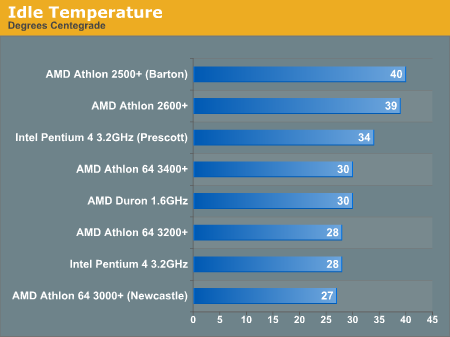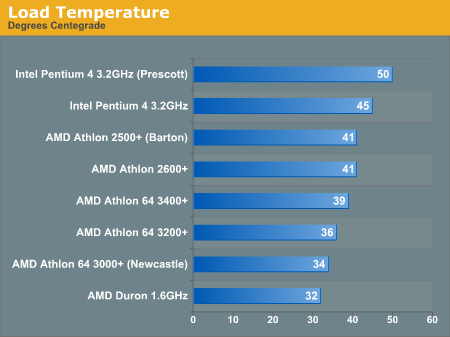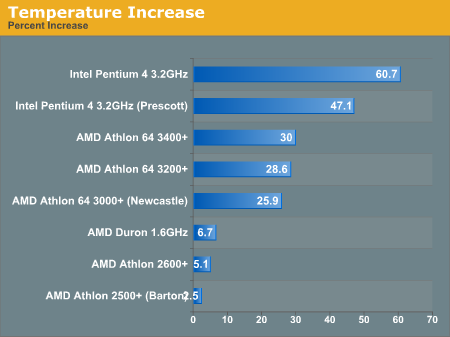CPU Heat Comparison: How Hot is Prescott?
by Derek Wilson on April 16, 2004 4:32 AM EST- Posted in
- CPUs
Processor Temperature Comparisons

We can see that, at idle, Prescott is 6 degrees Celsius hotter than Northwood. Of course, its only 4 degrees hotter than the 3400+ (and cooler than what we are reading for the Athlon XP processors). It is important to note that the Athlon XP and Duron processors do not have heat spreaders on them, and therefore will dissipate all of their heat into a more concentrated area of the heatsink (directly below the thermistor). This could help account for their temperature readings, but since their interface with the heatsink is so different, it may be better to only compare them with eachother.

Under load the gap between Northwood and Prescott is cut down by a degree. These two are now the hottest processors we are looking at, but 5 degrees of difference isn't all that much in looking at the temperature at the bottom of the heatsink near the contact area.

In looking at temperature increase in percentage, there isn't much point in ordering the graph. We don't even know what's better here. A small increase could mean that your processor doesn't draw that much more power under load, or it could mean that your architecture is inefficient in saving power when idle. We thought that these numbers were interesting though, so we included them.










48 Comments
View All Comments
PrinceGaz - Friday, April 16, 2004 - link
Interesting article, but I've a couple of suggestions :)If the fan on the heatsink was plugged into the motherboard used to test the CPU, you should instead run it off a dedicated stable regulated power source given an accurate known voltage. That totally isolates any effect the motherhoard, PSU load or anything else might have on HSF efficiency.
All current and future CPUs we're interested in have a heatspreader, which presumably does a decent job of spreading the heat over a fairly wide surface area compared to core-size of the processor (the AthlonXP/Duron line is effectively finished and won't concern enthusiasts, so their energy-consumption isn't too important). It seems a good way to translate recorded temperature over ambient temperature, into an actual power consumption in watts would be to make a little heater unit (with something like a heatspreader) you can mount the HSF on.
By adjusting the voltage applied to it and measuring the current you could take a whole range of readings covering a wide range of watts. You'd not only know whether the temperature difference rises linear with power, but also be able to give actual wattage figures for the CPUs. At least one site (whose name evades me) which does extensive HSF testing actually uses such a heater type system to compare HSF performance to ensure identical conditions.
From the results I must say I'm impressed with how well the Athlon 64 CPUs did, especially when running Prime95. Was Cool 'n Quiet enabled to reduce their speed in idle mode? If it was, I assume you did ensure with some utility they were operating at full speed while Prime95 was running? ;)
Prime95 is a great way to heat up processors but it may have a different impact on different CPU designs. The P4 runs it *FAR* faster than the AthlonXP does, or even the Athlon 64 despite the latter also having SSE2 instructions (which Prime95 uses). In particular have a look at the benchmarks page:
http://www.mersenne.org/bench.htm
and you'll see that for equivalent tests, the time taken by some different CPUs were:
Athlon XP 3200+ - 0.032, 0.066, 0.142
Athlon 64 3400+ - 0.025, 0.052, 0.116
Northwood 3.2GHz - 0.013, 0.026, 0.056
The Northwood 3.2GHz is running Prime95 roughly twice as fast as even the Athlon 64 3400+. Now while I can't say for sure that running it faster translates into more power-consumption, the fact that the test runs so much faster on that design makes the results difficult to trust. If however you've tried a whole bunch of different stress-test programs on the Athlon 64, Northwood and Prescott and found Prime95 gave the hottest temperatures on them all, thats fine. But if different tests give the hottest temperature for each design, then thats the one you should use for that design when carrying out future tests.
Sorry for rambling on so long, hope some of that made sense :)
CRAMITPAL - Friday, April 16, 2004 - link
http://www.theinquirer.net/?article=15374CRAMITPAL - Friday, April 16, 2004 - link
Obviously no one with a clue would buy a PressCrap when it clearly runs much hotter than the Northwood and is actually SLOWER in system performance. In InHell marketing speak that's called "90 nano performance". Sic !!! Now inHell is doing damage control after lower than expected profits and defective products they can't even deliver in quantity to Dull and WasteGate.Mumrik - Friday, April 16, 2004 - link
I meant an articles that claim the AXP only has a difference of 1Mumrik - Friday, April 16, 2004 - link
Doesn't seem very well done....How can we trust results that claim the AXP2500+ only have an idle/load temperature difference of 1 degree celcius?!
Pumpkinierre - Friday, April 16, 2004 - link
You didnt include the ambient air temp close to the fan (and fan speed- maximum or silent). Northwood temp range seems high. Cpu case temperature can be 10C under internal/diode temp.. 5C or so difference, both idle and load, between N'wood and Prescott is quite significant to an overclocker. The die size is approx. the same but given the 'missing 30 million transistors', 90nm and the large cache, the heat might be more localised on the Prescott affecting headroom. Good to see the a64 data. These AMD cpus seem to run cool.Voodoo80 - Friday, April 16, 2004 - link
What about cool and quiet? It's a pity this is not tested. I want to know what the idle temps would be if this is enabled.MAME - Friday, April 16, 2004 - link
Awww, I was hoping it'd be a heat nightmare and AMD would come to save the day!